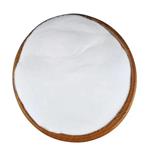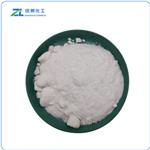Research on thermal activated delayed fluorescence materials based on diphenyl sulfone
Apr 25,2025
Introduction
Diphenyl sulfone (1,1′-sulfonylbisbenzene;DPS; Figure 1) is a known byproduct of the industrial synthesis of benzenesulfonic acids and chlorides and is also a known byproduct in the manufacture of phenol. In the past, diphenyl sulfone was applied as an ovicide and acaricide, but today it is used mainly in the polymer industry. Diphenyl sulfone has low toxicity for rats (LD50,UNR>2g/kg) and mice (LD50,IVN>2g/kg).[1]

1. Diphenyl sulfone-Acridine Skeleton Based High Efficiency Solution-Processed Thermally Activated Delayed Fluorescence Material[2]
In this thesis, a series of D-A TADF materials were constructed with 9,9-dimethylacridine (Ac) as the donor unit and diphenyl sulfone (DPS) as the acceptor unit, and the structure-property relationship of the materials was discussed in detail. The compounds’ structure was determined by hydrogen and carbon spectroscopy,time-of-flight mass spectrometry, high performance liquid chromatography and X-ray single crystal diffraction; the molecular configuration was optimized by density functional (DFT) theory calculation, hence the researcher studied the electron cloud distribution and energy level of the material. And the thermodynamic, photophysical and chemical properties of the compounds were studied in detail by weight loss analysis, steady-state/transient fluorescence spectroscopy, differential scanning calorimetry (DSC), polarized optical microscopy (POM), small angle X-ray scattering (SAXS) and cyclic voltammetry. Using these TADF molecules doped host material as the light-emitting layer dopant was prepared by solution processing method to further explore the electroluminescence properties. Here are research results of the paper following:
(1) In this thesis, the compounds m-DPSAc and p-DPSAc are used asluminescent cores, and mesogens are introduced into the 2 and 7 positions of the Ac donor unit to construct liquid crystal luminescent materials m-DPSAcLC and p-DPSAc-LC. The effect of material liquid crystal properties on its investigated. The thermal decomposition luminescent properties was temperature of both compounds exceeds 420 C, and both have smectic liquid crystals. Due to the difference in the attachment sites of the donor and acceptor the compounds m-DPSAc-LC and p-DPSAc-LC in toluene solution and doped films exhibited blue and green emission, respectively, and p-DPSAc-LC possessed TADF properties. The corresponding solution-processed devices were prepared by doping the two materials in the mCP host, and the device based on compound p-DPSAc-LC obtained 14.9% of EQEmax.
(2)A series of D-π-A compounds m-PyDPSAc, p-PyDPSAc and om-PyDPSAc were constructed by using Ac as the donor, diphenyl sulfone as the acceptor, and the pyridine ring as the n bridge. By changing the connection position of Ac unit to the π bridge, regulating intramolecular ICT effects, and discussing the effect of positional isomerism on compound properties in detail. These compounds have good thermal stability, and their decomposition temperature is greater than 340℃ at 5% thermal weight loss. All compounds show blue emission and TADF properties in doped films. With mCP as the host material these compounds D-π-A type compound is used as dopant material to prepare solution-processed blue device,in which the device based on p-PyDPSAc obtained an EQEmax of 6.68%.
(3)In order to further improve the luminous efficiency and color purity of TADF materials, the thesis constructed a class of conjugated rigid π bridge-dibenzofuran through intramolecular ring closure, and designed and synthesized the molecule diphenyl sulfone-BF-Ac. Compounds diphenyl sulfone-Ph-Ac, diphenyl sulfone-OMe-Ac and diphenyl sulfone-OH-Ac were prepared by changing the π bridge structure, and the effect of the n bridge structure on the photophysical properties of the materials was mainly discussed. These compounds all have good thermal stability (>380℃); both show blue emission (440-480 nm) in toluene and doped films, and all have obvious TADF properties. These compounds are doped with in mCP, solution-processed blue devices were prepared, in which the blue device based on the compound diphenyl sulfone-BF-Ac obtained an EQEmax of 24.69%. The blue material diphenyl sulfone-BF-Ac and the orange-red light material PO-01 were doped in mCP, a solution-processed hybrid white device was prepared, and its EQEmax was as high as 28.94%.The research results show that increasing the rigid structure of the molecule can effectively suppress the deformation of the excited state of the molecule,reduce the non-radiative transition of the molecule, and obtain a high-efficiency luminescent TADF material.
2.Diphenyl sulfone-based thermally activated delayed fluorescent materials[3]
This thesis mainly focuses on the design and synthesis of TADF molecules based on diphenyl sulfone-acridine skeleton, and discusses the relationship between structure and properties. The structure is determined by nuclear magnetic resonance spectroscopy and single crystal diffraction. The molecular orbital energy level and electron cloud density distribution were optimized by density functional theory calculation. The photophysical properties of the compounds were analyzed and discussed by UV-VIS spectrum, steady-state/transient spectrum, electrochemical testing, electrochemiluminescence testing and chemiluminescence testing. The research contents are as follows:
(1) A series of D-A TADF molecules were designed and synthesized by using diphenyl sulfone-acridine as the skeleton and selecting several groups with different electron supplying properties (methoxy, methyl, trifluoromethyl, cyanide) as substituents. DMAC-DPS-OMe, DMAC-DPS-CH3, DMAC-DPS-H, DMAC-DPS-CF3, DMAC-DPS-2CF3, and DMAC-DPSCN. The effects of different substituents on the molecular skeleton and its luminescence properties were investigated. The results showed that the stronger the electron donor ability of the substituents, the better the luminescence performance of the series of compounds, and the properties of aggregation-induced luminescence enhancement, when the water doping ratio is high enough, the luminescence intensity can be significantly enhanced.
(2) A series of TADF molecules were designed and synthesized by modifying the framework of diphenyl sulfone-spiro acridine and diphenyl sulfone-acridine respectively through methoxy, methyl and hydroxyl groups that may cause hydrogen bonding. SBA-2DPS4OMe, SBA-2DPS-2OMe, SBA-2DPS-tBuPh, DMAC-DPS-2OMe, SBA-2DPS-4OH, DMAC-DPS-2OH. The compound with spiro acridine as donor showed better luminescence properties than acridine. Compound SBA-2DPS-2OMe showed weak electrochemical luminescence and good chemiluminescence, with an efficiency of 0.00235%. The chemiluminescence efficiency of compound SBA-2DPS-tBuPh is 0.00397%.
(3) A series of TADF molecules were designed and synthesized by using diphenyl sulfone acridine as the framework and by introducing ions into substituents. 10-channel DMAC-DPS(diphenyl sulfone)-Di (n-Bu), [DMAC-DPS(diphenyl sulfone)-Di (Im+)] [BF4-], [DMAC-DPS-Di (Im+)] [PF6-], [DMAC-DPS-Di (Im+)] [I-], [DMAC-DPS(diphenyl sulfone)-Di(Im+)] [TFSI-], [DMAC-DPS(diphenyl sulfone)-Di(Im+)][FSI-].The introduction of ions can control the emission wavelength and luminous region of the luminescent materials.
References
[1]KRISTIN A FLETCHER, CARMEN E HERNÁNDEZ, LINDSAY E ROY, et al. Solubility of diphenyl sulfone in organic nonelectrolyte solvents. Comparison of observed versus predicted values based upon the general solvation model[J]. Canadian Journal of Chemistry,1999,77(7):1214-1217. DOI:10.1139/v99-116.
[2]ZHU Y YUAN. Design, Synthesis and Properties of Diphenyl sulfone-Acridine Skeleton Based High Efficiency Solution-Processed Thermally Activated Delayed Fluorescence Material[D].Changzhou university,2022.DOI:10.27739/d.cnki.gjsgy.2022.000454.
[3]WU TONG. Design, synthesis and performance study of diphenyl sulfone-based thermally activated delayed fluorescent materials[D].Jianghan University,2023.DOI:10.27800/d.cnki.gjhdx.2023.000015.
- Related articles
- Related Qustion
The derivatives of per?uorooctyl iodide (PFOI) are widely used, so PFOI as an intermediate in chemical industry, has a higher commercial value.....
Apr 24,2025Organic Synthesis IntermediateTetrabutylammonium acetate is a good source of nucleophilic acetate ion and can be used to catalyze the alkynylation of carbonyl compounds.....
Apr 25,2025Chemical MaterialsDiphenyl sulfone
127-63-9You may like
Diphenyl sulfone manufacturers
- Diphenyl sulfone
-

- $999.00/ g
- 2025-04-27
- CAS:127-63-9
- Min. Order: 1g
- Purity: 99%
- Supply Ability: 5000
- Diphenyl sulfone
-

- $10.00 / 1KG
- 2025-04-23
- CAS:127-63-9
- Min. Order: 1KG
- Purity: 99%
- Supply Ability: 5tons
- Diphenyl Sulfone
-

- $65.00 / 1kg
- 2025-04-15
- CAS:127-63-9
- Min. Order: 1kg
- Purity: 99%
- Supply Ability: 20ton






